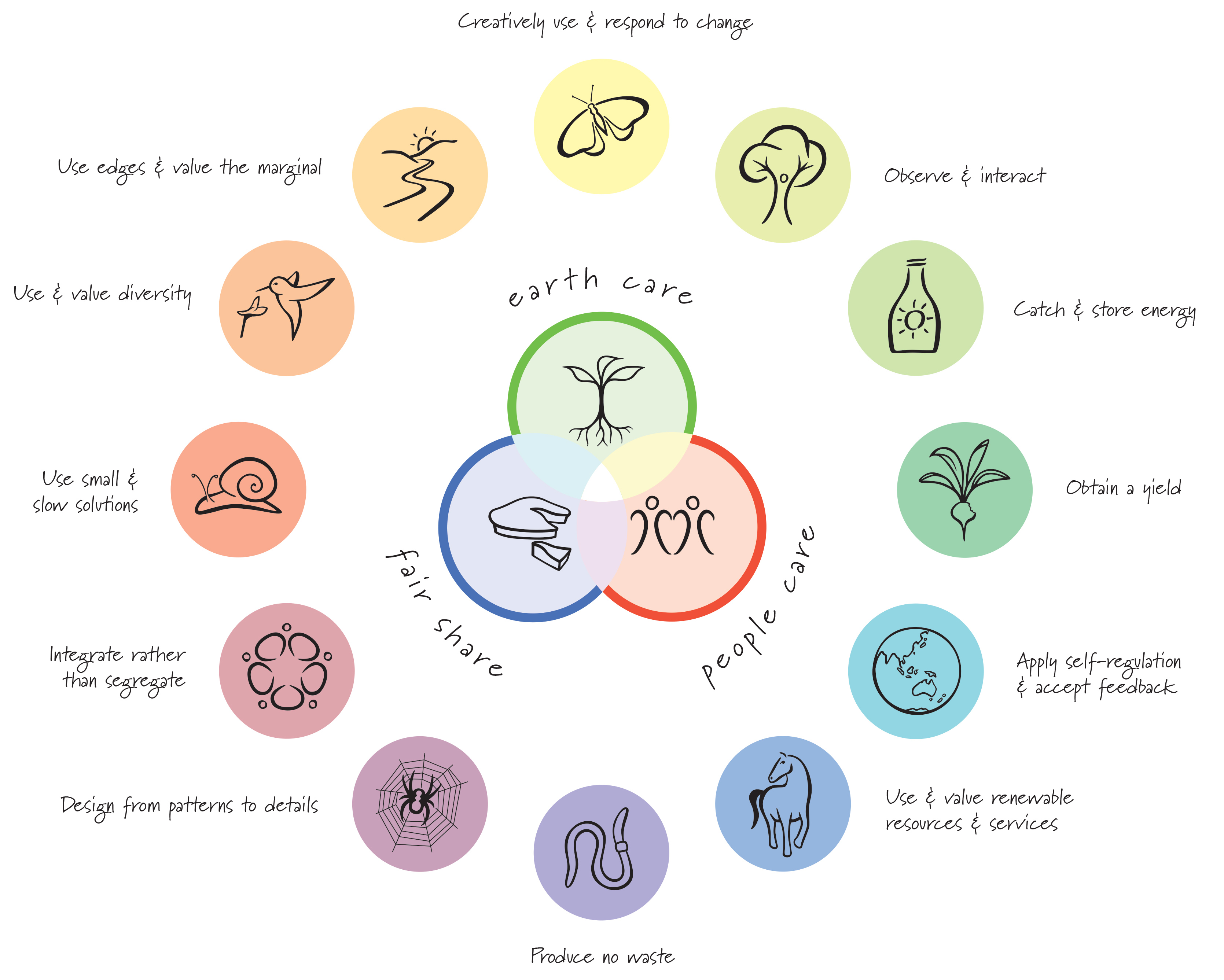No products in the cart.
NEWS
Exploring Permaculture Principles: A Comprehensive Insight into Sustainable Design
0 
Introduction
Permaculture, as articulated by David Holmgren in “Permaculture: Principles and Pathways Beyond Sustainability,” operates on the foundation of three core ethics: Earth Care, People Care, and Fair Share.
These ethics form the ethical compass guiding the design principles, creating a holistic framework for sustainable living.
In this exploration, we delve into the interconnection between Holmgren’s permaculture design principles and these foundational ethics, illustrating how each principle contributes to the ethical imperatives of caring for the Earth, its people, and ensuring equitable resource sharing.
This symbiotic relationship underscores a comprehensive approach to harmonizing human activities with ecological principles, fostering resilience, and promoting a balanced and sustainable coexistence.
Earth Care (Ethic 1):
- Related Principles: Observe and Interact, Catch and Store Energy, Use and Value Renewable Resources and Services.
- Connection: Careful observation of the Earth, capturing and storing solar energy, and optimal use of renewable resources are fundamental to ensuring the long-term well-being of the Earth.
People Care (Ethic 2):
- Related Principles: Obtain a Yield, Apply Self-Regulation and Accept Feedback, Use Edges and Value the Marginal.
- Connection: Focusing on projects that provide tangible benefits, self-regulation of systems to adapt to human needs, and valuing “marginal spaces” align with the care for people and communities.
Fair Share (Ethic 3):
- Related Principles: Use and Value Diversity, Use Small and Slow Solutions, Use Edges and Value the Marginal, Creatively Use and Respond to Change.
- Connection: Emphasizing diversity, gradual solutions, and creative responses to change contribute to promoting fair share of resources, ensuring that each element of the community has equitable access to necessary resources.
This interweaving of principles and ethics represents a holistic approach to sustainable design and management, emphasizing harmony between the environment, people, and equitable distribution of resources.
Introduction to the 12 Principles of Permaculture
The 12 permaculture design principles, meticulously outlined by David Holmgren in “Permaculture: Principles and Pathways Beyond Sustainability,” constitute an indispensable compendium for crafting sustainable and harmonious systems.
These principles transcend conventional guidelines for environmental design.
They embody an ethical and holistic approach to human interaction with the surrounding environment.
Immersed in the philosophy of permaculture, these principles extend beyond the creation of productive gardens.
They serve as the bedrock of a mindset and lifestyle deeply rooted in sustainability.
Interconnected and interdependent, these principles seamlessly integrate with the core ethics of permaculture: Earth Care, People Care, and Fair Share.
This introduction extends an invitation to explore each principle, fostering a deeper understanding of how permaculture-based design can cultivate a profound connection with the Earth, genuine well-being for people, and equitable resource distribution for present and future generations.
Permaculture is more than a design practice; it is a way of life that reflects an enduring commitment to sustainability and harmony with our planet.
Now, let’s embark on an in-depth exploration of these principles!
Armed with a foundational understanding of the ethical pillars and overarching philosophy of permaculture, let’s now closely examine each of the twelve design principles.
These principles serve as actionable guidelines, shaping not only the design of physical spaces but also our approach to challenges, decision-making, and the cultivation of a sustainable and harmonious way of life.
Each principle encapsulates a unique facet of permacultural thinking, offering insights into creating regenerative systems that honor the Earth, prioritize the well-being of people, and advocate for the fair and equitable sharing of resources.
Join us on this journey of exploration as we uncover the wisdom embedded in each principle, seeking inspiration for a more resilient and balanced future.
1. Observe and Interact:
- Explanation: Thoughtful observation of nature, approached with a contemplative and interactive mindset, forms the bedrock of every permaculture project. Before intervening in an environment, understanding its patterns, flows, and dynamics is essential to craft solutions tailored to specific needs.
- Practical Example: Prior to designing a garden, dedicate time to observe weather conditions, light patterns, and interactions among existing plants. This knowledge will inform the layout of crops and the creation of favorable microclimates.
2. Catch and Store Energy:
- Explanation: This principle advocates for the efficient harnessing of resources during periods of peak abundance to ensure a stable supply over time.
- Practical Example: Install a solar energy collection system, such as photovoltaic or solar panels, to capture and store energy during sunny days. Utilize this stored energy when the sun is not available.
3. Obtain a Yield:
- Explanation: Focusing on projects that yield meaningful returns ensures that efforts expended translate into tangible benefits.
- Practical Example: Cultivate a garden to yield nutritious and flavorful produce. Gardening not only provides personal satisfaction but also produces fresh, local food.
4. Apply Self-Regulation and Accept Feedback:
- Explanation: Design should encourage systems capable of self-regulation and adaptable to feedback for flexible adaptation to variations.
- Practical Example: Implement water conservation practices at home, monitor consumption, and adjust habits based on feedback, promoting sustainable water resource use.
5. Use and Value Renewable Resources and Services:
- Explanation: Optimizing the use of renewable resources reduces dependence on non-renewable ones, contributing to long-term sustainability.
- Practical Example: Prefer renewable energy sources such as wind or hydroelectric power over fossil fuels, reducing environmental impact and fostering the adoption of sustainable practices.
6. Produce No Waste:
- Explanation: Embrace a mindset of valuing and utilizing all available resources, leaving no room for waste and fostering a commitment to resource efficiency.
- Practical Example: Implement composting systems to recycle organic waste, turning it into nutrient-rich soil amendments, closing the loop on waste disposal.
7. Design from Patterns to Details:
- Explanation: Begin the design process by observing and understanding the patterns inherent in both nature and society, using these overarching patterns to inform the subsequent addition of intricate details.
- Practical Example: In urban planning, analyze existing traffic patterns and social behaviors before detailing the layout of streets and public spaces, ensuring a harmonious and functional environment.
8. Integrate Rather Than Segregate:
- Explanation: Facilitate the development of relationships between various design elements, creating a cohesive system where components work harmoniously to support each other.
- Practical Example: In agriculture, practice companion planting, where different crops with symbiotic relationships are grown together, enhancing soil fertility and pest control without the need for external inputs.
9. Use Small and Slow Solutions:
- Explanation: Favor the implementation of small, gradual systems that are easier to maintain, capitalize on local resources more effectively, and yield more sustainable outcomes in the long run.
- Practical Example: Choose slow-release, organic fertilizers over synthetic ones in gardening, promoting soil health and reducing the risk of nutrient runoff.
10. Use and Value Diversity:
- Explanation: Harness the power of diversity to reduce system-level vulnerability to threats, fully capitalizing on the richness and resilience inherent in diverse ecosystems.
- Practical Example: In community development, encourage diverse skill sets and perspectives, fostering a dynamic and adaptable environment that thrives on different strengths.
11. Use Edges and Value the Marginal:
- Explanation: Recognize the inherent value in the borders and edges of systems, where unique and productive interactions often occur.
- Practical Example: In landscaping, create edge zones between different types of vegetation, promoting biodiversity and providing habitats for beneficial insects and wildlife.
12. Creatively Use and Respond to Change:
- Explanation: Embrace change as an inevitable force and proactively respond to it through careful observation. Intervene thoughtfully and timely to positively influence and adapt to the evolving dynamics of a system.
- Practical Example: In business, implement agile management practices that allow for quick adaptation to changing market conditions, ensuring long-term sustainability and resilience.
Explore Mollison’s Principles



